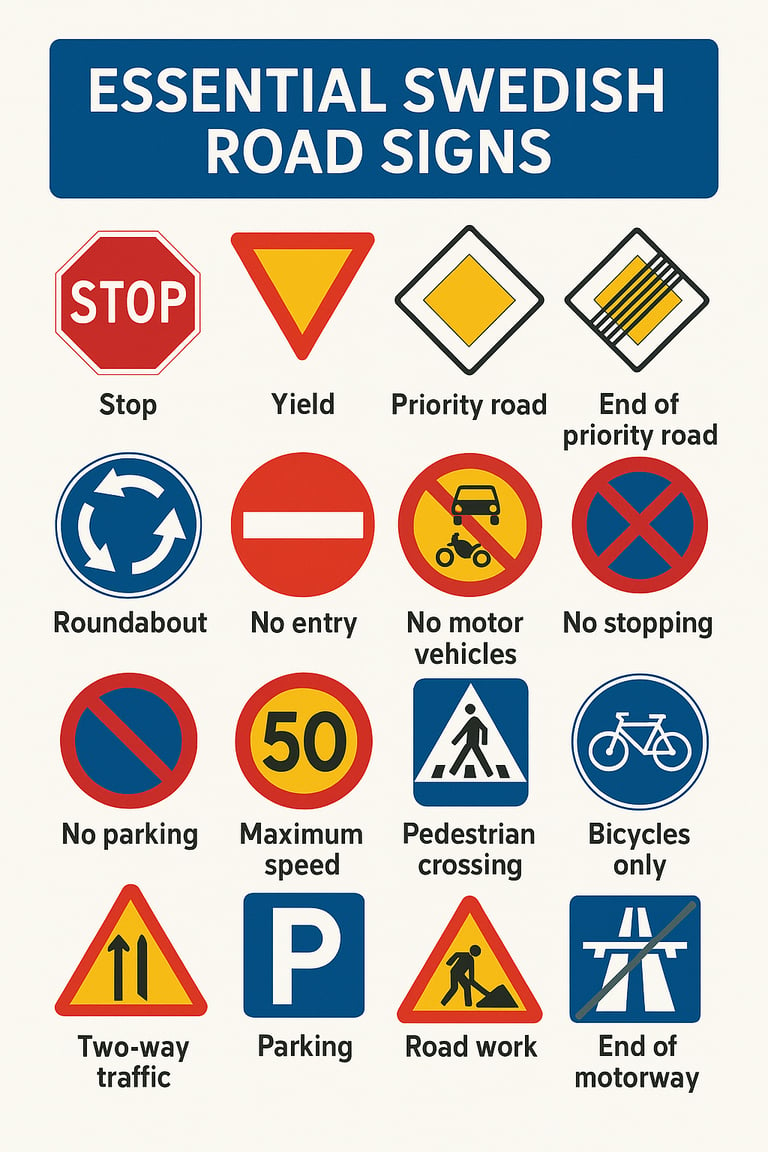Renting a Car & Driving in Sweden: Rules for All Seasons
Planning to rent a car in Sweden? This up-to-date guide covers key road rules, winter driving and studded tires, the 0.2‰ alcohol limit, speed and parking basics, insurance, congestion/toll notes, and wildlife-collision steps.
SWEDEN
Zayera Khan
11/3/20256 min read
Renting a car is a fantastic way to see Sweden, from the southern coast to the northern wilderness. But before you hit the road, you need to know the rules, which are often stricter than in other parts of Europe—especially regarding alcohol and winter equipment. Here’s your guide to driving safely and legally in Sweden.
Renting a Car in Sweden
Getting your rental is straightforward, but keep these points in mind:
License: A valid driving licence from an EU/EEA country is accepted. If your licence is from a non-EU country and not in English (or German/French), you will need an International Driving Permit (IDP).
Age: You must be at least 18 to drive, but most rental companies require you to be at least 21 (and often 25) for a standard car. Drivers under 25 will almost certainly pay a "young driver" surcharge.
Payment: A credit card in the main driver's name is almost always required for the deposit. Debit cards are rarely accepted.
Transmission: Manual transmission (stick shift) is still very common. If you only drive automatic, make sure to filter for and book one specifically, as they are less common and may cost more.
The #1 Rule: Sweden's Strict Drink-Driving Limit
This is the most critical rule to understand. Sweden has one of the strictest drink-driving laws in the world, and enforcement is frequent and non-negotiable.
The Limit: The legal blood alcohol limit (BAC) is 0.2‰ (per mille), which is equivalent to 0.02%.
What this means: For most people, this is less than one small beer or glass of wine.
The Law: The offense is called rattfylleri (drunk driving), and penalties are severe, including heavy fines and prison time, even for a first offense.
The only safe rule is a zero-tolerance policy: If you are driving, do not drink any alcohol.
Driving in Winter (1 December – 31 March)
Winter driving is taken very seriously. If you are renting a car during this period, the vehicle will be equipped correctly by law.
Mandatory Winter Tyres
The Rule: From 1 December to 31 March, winter tyres are mandatory if winter road conditions exist.
"Winter Conditions" Defined: This means there is any snow, ice, slush, or frost on any part of the road. In reality, you should have them on for the entire period.
Tread Depth: The minimum legal tread depth for winter tyres on cars is 3 mm. (Your rental company will handle this).
Studded Tyres (Dubbdäck) vs. Friction Tyres
You will be given one of two types of legal winter tyres:
Friction Tyres (Odubbade): These are non-studded tyres, common in southern Sweden (like Malmö and Gothenburg).
Studded Tyres (Dubbdäck): These have small metal studs for grip on ice and are common in Stockholm and the north.
Studded Tyre Dates: Studded tyres are only legally allowed from 1 October to 15 April. They are banned outside these dates unless winter conditions persist.
⚠️ Important City Ban: To reduce air pollution, some major cities have studded tyre bans (dubbdäcksförbud) on specific streets. The most famous is Hornsgatan in Stockholm. If you have studded tyres, your GPS or local signs will (in theory) route you around these streets.
Driving in Other Seasons (Spring, Summer & Autumn)
Driving in the warmer months is beautiful, but it comes with its own set of rules and hazards.
Headlights On. Always. This is a legal requirement 24/7, all year round. Your car's daytime running lights will handle this.
The Wildlife Hazard: The biggest danger in summer and autumn is wildlife.
When: Animals, especially moose (älg) and roe deer (rådjur), are most active at dusk and dawn.
Where: Pay extreme attention on unfenced rural roads, especially those marked with a triangular animal warning sign.
What to do: Scan the sides of the road, not just the road ahead. If you see one animal, slow down—there are often more behind it. A collision with a 1,000-pound (450 kg) moose can be fatal.
SEO keywords: winter tyres Sweden rules, Sweden BAC limit, drive in Sweden winter, studded tyres dates, renting a car Sweden, 0.2 alcohol limit Sweden, driving in Sweden summer, moose warning Sweden, dubbdäcksförbud Stockholm, International Driving Permit Sweden#RoadTripSweden #WinterTyres #DriveSafe #SwedenTravel #Älg #Rattfylleri #DriveSweden
🇸🇪 Essential Driving Tips for Tourists in Sweden - Summarized
Driving in Sweden is generally a relaxed and pleasant experience, but visitors must be aware of key differences, especially regarding safety and seasonal rules.
🚦 Core Road Rules
Drive on the Right: Sweden drives on the right side of the road.
Headlights ON, Always: It is mandatory to use dipped (low-beam) headlights or daytime running lights (DRL) at all times, 24 hours a day, all year round. Your rental car will likely handle this automatically.
Speed Limits: Speed limits are strictly enforced and vary widely. Always follow the signs (which are in km/h):
Built-up Areas: Often 30 km/h or 50 km/h.
Major Roads/Highways: Typically 90 km/h or 100 km/h.
Motorways (Motorväg): Mostly 110 km/h, sometimes up to 120 km/h on certain stretches.
🚫 The Strict Alcohol Limit
Zero Tolerance: Sweden has one of the world's lowest legal Blood Alcohol Content (BAC) limits: 0.2‰ (0.02%).
Rule: This is less than one small drink for most people. The only safe rule is do not drink any alcohol if you plan to drive. Penalties are extremely severe.
❄️ Winter Driving (1 Dec – 31 Mar)
Mandatory Winter Tyres: Between 1 December and 31 March, winter tyres are mandatory if winter conditions (snow, ice, slush, or frost) exist on the roads. Rental cars during this period will be equipped correctly.
Studded Tyres: Studded tyres are generally permitted from 1 October to 15 April. Be aware of local bans in some city areas (like parts of Stockholm) aimed at reducing air pollution.
🦌 Wildlife Hazard
Be Alert: Sweden has frequent wildlife crossings, especially by moose (älg) and roe deer.
When: Animals are most active at dusk and dawn.
Where: Be extra vigilant on rural and forest roads marked with animal warning signs. If you see a moose, slow down immediately—a collision can be fatal.
🦌 Fast Facts: Roadkill Accidents (Viltolyckor) in Sweden, 2025
Sweden experiences an extremely high rate of traffic accidents involving wildlife, collectively known as viltolyckor.
📈 The Rising Trend
Record High: The number of reported wildlife accidents across Sweden's road network continued to increase in 2025 and is projected to reach a new record level, potentially well over 70,000 incidents for the entire year.
First Half 2025: The first half of 2025 alone saw over 30,500 reported wildlife collisions.
🦌 Which Animals are Most Affected?
The overwhelming majority of incidents involve smaller deer, but the most dangerous accidents involve larger animals.
Roe Deer (Rådjur) Over 40,000 incidents
Wild Boar (Vildsvin) Over 9,000 incidents
Moose (Älg) Over 5,000 incidents with the highest risk of human fatality or serious injury due to the animal's height.
📍 Where Do Accidents Occur?
Regional Increase: The sharpest increases in accidents are being reported in the densely populated, southern Swedish counties like Halland, Kronoberg, and Skåne.
Time of Day: Accidents peak during dusk and dawn, when visibility is poor and animals are most active.
⚠️ Advice for Drivers
Mandatory Stop: If you are involved in a collision with any of the major species (Moose, Deer, Wild Boar, etc.), you are legally obliged to immediately stop and report the accident to the police (112), even if the animal runs away.
Mark the Spot: You must mark the collision location clearly (often with a special ribbon handed out at gas stations or rental agencies) so search teams can find the injured animal. Failure to report is a crime.
Be Vigilant: Pay close attention to the triangular yellow and red wildlife warning signs—they are placed where accidents are common.
🚨 PSA: You Must Report Roadkill in Sweden
⚠️ Legal Requirement for All Drivers
If you are a tourist driving in Sweden and are involved in a collision with certain wild animals—including Moose, Roe Deer, Wild Boar, Lynx, Bear, Wolf, Red Deer, or Fallow Deer—you have an immediate legal obligation to follow specific steps.
Step 1: Stop and Secure
STOP: Immediately stop the vehicle safely.
SECURE: Switch on your hazard lights.
Step 2: Call the Police (112)
REPORT: Call the police immediately via 112, regardless of the time of day, and report the accident.
Do Not Chase: Never attempt to chase or follow an injured animal yourself.
Even if the animal runs away, you must report the incident.
Step 3: Mark the Location
MARK IT: You are legally required to mark the precise spot where the collision occurred, or where the animal disappeared into the woods.
Why? This ensures that official search teams (eftersök) can quickly locate the injured animal to end its suffering.
Tool: Use a special wildlife marker ribbon (viltolycksremsa), often found in gloves compartments of rental cars or available at gas stations. Tie it visibly near the point of impact.
Legal Warning: Failing to stop and report a collision with these animals is a criminal offense (smitning) in Sweden, resulting in heavy fines or jail time.






